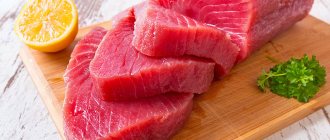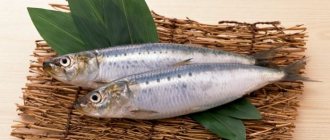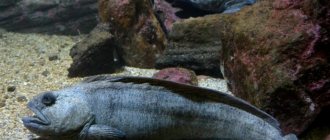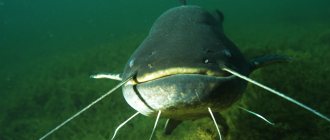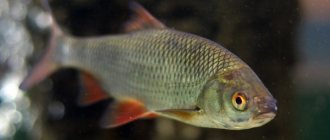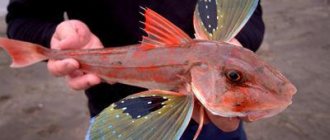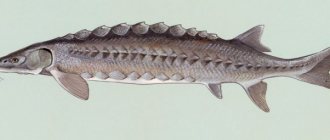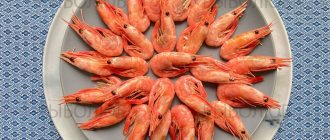Which family does it belong to?
In the international classification, burbot is a representative of the Cod family (subfamily Lotinae) and belongs to the genus Burbot. In Russian science, the burbot genus is considered to be the burbot family.
Burbot description:
| International scientific name: | Lota lota |
| Class: | Ray-finned fish |
| Squad: | Codfish |
| Family: | cod |
| Genus: | Burbot |
| View: | Burbot |
The only fish from the cod order that is found in fresh water.
Where to live and lifestyle
Burbot belongs to the cod family, and can be found in both fresh and salt water, but most often it can only be found in fresh water bodies.
Its habitats are rivers, lakes and deep ponds, but not every body of water is suitable for its life.
Burbot prefer reservoirs with a rocky, sandy and gravel bottom; it can almost never be found where there is silt at the bottom.
The quality of water in a reservoir plays an important role; cold water and a large amount of oxygen are important for it.
The ideal water temperature at which burbot leads an active lifestyle is from 4 to 18 °C.
It needs shelter in the form of tree roots, flooded snags, bushes and stones.
Often found near bridge supports, piers and other artificial structures.
It is not possible to detect the burbot's habitat by external signs; it does not jump out of the water or blow bubbles while digging in the ground. You can find its habitat by external signs, or you need to collect information from local fishermen or from reports on reservoirs, or search on your own by fishing for suitable places, but due to the nocturnal lifestyle of this fish, this is problematic.
We recommend: What glue to use for repairing PVC boats
What does burbot look like?
Due to its specific appearance, it is difficult to confuse it with any other fish. It bears slight resemblance only to catfish.
Photo: Burbot fish
The body of the burbot is elongated, spindle-shaped, tapering towards the tail. The small head is flattened with small eyes, flattened. The mouth is large, the upper jaw is larger than the lower jaw. Bristly teeth are located on the jaws and vomer.
Photo of burbot head
The main distinguishing feature is one antennae located on the chin and two on the upper jaw. The anal and dorsal fins are oblong, reaching the tail.
Color depends on habitat.
- Burbot has a dark brown or black body if its place of residence is a rocky bottom, snags, or dark soil.
- The light brown predator is found on sandy soil.
There are brown spots on the sides, their arrangement is chaotic.
The body can reach 120 cm with a weight of 15-18 kg. Average weight is 3 kg.
What are the main nuances you need to know before starting a burbot hunt?
Before you start catching burbot, you need to prepare:
- it is important to know whether burbot fishing is prohibited in a particular region today;
- if fishing is allowed, then you need to find out where you can do it;
- fishing for burbot will be successful from mid-autumn to mid-spring;
- night fishing is the only chance for catching burbot in the summer;
- burbot is quite passive and is found at great depths.
«>
You can get a predator from the open area and from under the ice. Fishing for burbot should be done in the dark, late evening and at night. Because this fish does not show the slightest activity during the day. The burbot bite depends on weather conditions.
Interesting fact: burbot begins to show its activity during the period of worsening weather conditions, when all the other fish go underground.
Lifestyle
Burbot is notable for its love of cold. Feels great in water with a temperature of +11.5°C and below. Being in warm water leads to a state of suspended animation - the fish is not active. Therefore, during the warm summer period, the fish spends “hibernation”, hiding in “burrows” among stones, holes and snags.
But with the onset of cold weather it becomes most active. Zhor begins in October-November, spawning occurs in December-January.
In reservoirs it lives near the bottom and hunts at night. It can lead both a sedentary lifestyle and migrate over fairly long distances. Small fish can flock together in schools, while adults keep to themselves.
This is interesting: - Adult representatives of the burbot family can go without food for a long time. — Frequent parking areas are places next to cold springs. — Burbot does not tolerate heat and light, so fishing for it is most effective on a moonless night in the cold season.
What does burbot eat and what is used to catch it?
At dusk he goes out hunting. Burbot feeds on small fish: ruffe, gudgeon, goby, perch, and silver bream. The diet includes benthic invertebrates, as well as frogs and crustaceans.
In addition, it cleans the pond - it is a scavenger. Swimming along the bottom, it eats dead, decaying animals and fish. Often, to catch him, they use rotten meat, which he loves so much. Of the live baits, the most readily caught is the ruff.
Is burbot a scavenger?
A representative of the Cod order is both a scavenger and a predator. In winter, it leads an active lifestyle, and burbot often eats dead fish that it finds at the bottom.
Experienced fishermen advise using crucian carp, ruffe, goby, silver bream, gudgeon as bait - that is, those fish that he is used to feasting on in the river.
Burbot fishing
Burbot biting schedule
The key to successful burbot fishing is knowledge of its habitats and the seasonality of fishing. Random bites in your area from the second half of April to the beginning of September indicate that burbot are found in your area. You should remember these places, since fishing for burbot in the fall can be most successful there, since the burbot usually moves along its own paved paths.
Fishermen - burbot hunters - distinguish three periods of the greatest activity, and therefore the bite, of this fish: autumn (from October to freeze-up), winter (December - February) and spring (March - April). After a summer fast, when children could even pull a half-asleep burbot out of a hole or from under a snag with their bare hands, he rewards himself for a long fast. The lower the water temperature becomes, the darker the nights (burbot hunts for prey mainly at night), the greater the predator's appetite.
Burbot fishing is done with rods and shells close to the rod, almost exclusively in winter, during spawning. Hunting fishing itself can be divided into spring, autumn and winter; In the summer, burbots are not caught with a fishing rod at all. Since this fish feeds only at night and walks along the very bottom, it can only be fished at night and from the bottom; At the same time, it was noticed that the darker the nights and the worse the weather, the better the burbot takes. On moonlit nights, as mentioned above, it bites poorly, also (at least in some places) on the new month; nevertheless, the fire of a fire or a lantern undoubtedly attracts burbot and improves their bite, so light is necessary not only for the convenience of the angler.
Fishing for burbot in spring
Fishing is done in the spring almost always from the shore, rafts, less often from boats - for the reason that at this time the burbot stays near the shore, under steep ravines, in deep places. The fishing rods are short (including juniper poles 1 m long), and if fishing from the shore or raft, up to 10 or even 15 fishing rods are immediately placed, stuck into the ground or between logs. Fishing lines - hairline, 6-8 b. h. white hair; Moreover, since they are caught in deep places and the burbot presses close to the shore, there is no need for the length of the fishing line to significantly exceed the depth of the water. Almost a sinker. something heavy is always required, in accordance with the strength of the current of large water; for the most part it is a 20- or 14-gauge bullet. Most people tie the hooks directly to the fishing line, but it is much more practical to use separate leashes with a loop, which is threaded in a known manner into a large loop at the end of the fishing line, so that the leash can easily be replaced by another, which is very important when the burbot has swallowed the bait deeply. Many fishermen-hunters use for this purpose a special elongated sinker with 2 rings, to which a leash and fishing line are attached; This device is even more convenient, but an oblong sinker is generally worse than a round one. The leader is made either from hair, slightly thinner than fishing line, or from a vein, incorrectly called buffalo hair. It should be noted, however, that where large burbots are found or where there are so many fishing rods that they do not have time to inspect them often (many people put fishing rods at night and inspect them in the morning), the burbot can grind the leash with their small, brush-like teeth, and therefore It is more prudent to make leashes from thin basques. Hooks can be of different sizes, from No. 1 (and larger) to No. 6, depending on the bait and the size of the fish in the area, but it is better if they have a long shaft and a sawed-off barb; burbot swallows deeply, and it is very difficult to remove a short hook with a notch without crushing the fish, and each time you have to either cut off the hook and tie a new one, or change the leash itself;
The usual spring bait for catching burbot is a crawler, that is, a large earthworm, or several red worms; The first one is put on from the head, slightly retreating from it, and part of the crawl should be on a leash. In the spring, as you know, any fish takes a worm better than at other times of the year, since a lot of worms fall into the river with hollow water. You can, of course, catch burbot on a piece of fish, even meat, as in the fall, but these baits are less tempting for it than a live worm, and live bait is difficult to get in the spring. However, in some places the burbot takes a good bait on a frog in the spring. It is remarkable that in large rivers it is caught almost exclusively with a worm and with a frog only in small rivers.
Fishing for burbot in summer
Throughout the summer, burbots are almost never caught on fishing rods, unless by accident. In summer, burbot can generally be caught only by hand, pulling it out of holes, from under the roots of coastal trees and bushes, as well as from under stones. This method of fishing, called groping, or squinting, is used everywhere, especially on small steep rivers, and has many fans among peasants, especially boys. It consists in the fact that on a hot day the fisherman enters the water no deeper than chest-deep, and carefully, without making noise, feels with his hands all the depressions of the shore, crayfish holes, roots, and also stones; Having heard by touch a fish standing above the shore or huddled in a hole, he quickly snatches it out of the water and throws it ashore. Probing is always done in dark places, under overhanging trees, on steep banks, and also near springs and springs. Almost all kinds of fish are caught this way - roach, ide, pike, carp, but most often burbot, which are the most sensitive to heat, despite their slipperiness, which requires great skill. It is remarkable that burbots are completely indifferent to touching and with some skill it is not difficult to even force them to take a more comfortable position.
Catching burbot in autumn
Burbot camps in autumn
Autumn fishing begins as soon as the water gets cold and the burbot crawls out of strong and deep places into more open and shallow ones, which happens around the twentieth of August. In general, the rules for fishing with a fishing rod at this time are the same as in the spring; The only difference is in the place of fishing and in the greater variety of baits.
At the end of summer and early autumn, burbot still bites in fits and starts, in bad weather and cold weather, stopping the bite when the barometer rises; Only in October and November does the burbot flow almost evenly, without interruptions. More fish are caught from boats than from the shore, with longer lines than in the spring and with a less heavy sinker. The gear is the same, the bait is also a worm (a crawler and a red worm), but more for small (1-2 year old burbot), more often a gudgeon or a ruff, and sometimes a frog. The best bait for burbot is a gudgeon, then a char and, finally, a ruff, and there is no particular need for them to be alive, and in places where the burbot is small (from 200 g to 1.2 kg), it is even more useful to cut these fish into 2-3 parts. A whole fish is baited either by the lip (the usual way of baiting live bait in the current, since with it the fish lives longer and takes a natural position), or by the tail, into the spinal column, and although the fish dies, it holds on tighter, and the burbot is not so deep swallows the hook. Live fish, of course, are placed on a hook with a barb, since it can easily come off it. Some fishermen trim the dorsal fin of ruffes, but this is completely in vain, since the burbot mouth is apparently completely insensitive to pricks. In general, the main autumn bait is gudgeon, whole or cut into pieces. In any case, the bait should lie on the bottom, and in this habit of burbot, taking food only from the bottom, one must look for an explanation for the fact that it more readily takes pieces of roach, dace and other bottom-dwelling fish than these live fish. With a good bite and in the absence of other baits, sometimes they successfully catch burbot using pieces of liver and meat, and there have even been cases using pieces of salted herring. It would do well for anglers to pay more attention to this last bait, mainly for the reason that the burbot’s relative - cod - Norwegians, in the absence of bait (capelin), always catch with salted herring. And generally speaking, every fish loves salt; You can get herring everywhere and always, and it retains its salty taste for a very long time and, in a smooth current, can attract fish from a long distance.
Fishing for burbot in winter
Winter fishing for burbot
Winter fishing for burbot begins in central Russia usually in early December and continues throughout January; in February its bite stops, resumes with warm weather at the end of this month and ends with ice drift. Amateur fishermen fish for burbot in almost the same way as for ruffs - with fillies and hair lines; the only difference is that all the gear is coarser, the bait is different, and fishing is done in sandy or gristly shallow places. Since a large burbot can easily drag a filly under the ice, the latter is made larger and, in addition, either has iron pegs in both of its heels for sticking, or these heels are soaked in water and frozen to the ice. The line is 6-12 hairs, depending on the average size of the burbot found in the area, although the latter, as is known, offer relatively weak resistance when pulled out, but in winter they, unlike other fish, do not lose their strength at all. They fish vertically or with a slight slope so as not to cut the lines on the ice. Hooks are used mainly with long rods from No. 5 to 0 and larger, depending on the bait and size of the fish, and it is better if their barb is cut off. Some anglers even catch burbots using hooks bent from pins or hairpins. Burbot, like any other swallowing fish, can be caught by threading the bait with a sewing needle tightly tied to the fishing line in the middle. The weight is attached to the fishing line no more than 18 cm from the hook and must lie motionless on the bottom, not be lifted by the current and not roll along the bottom; since in the middle of winter it is necessary to catch burbot in rather fast-flowing places, a relatively very heavy and, moreover, flat sinker is used, lying calmly on the bottom.
The best bait for burbot, with the exception of small ones, is either live small fish or pieces of fish. Small ruffe are most often, sometimes exclusively, used as winter bait, since gudgeons are more difficult to get in winter, and other fish usually cannot stay at the very bottom or soon fall asleep. They also catch burbots with worms and frogs, but very rarely, since both need to be stocked up in the fall, and you can get as many ruffs as you want; Moreover, burbot is almost as willing to take pieces of fish, fresh and salted, even the entrails of animals - liver, lungs, chicken giblets, and finally, pieces of meat and lard. When fishing for a live fish or frog, doubles, of course, are not used, since the leashes get very tangled. Live bait is attached either by the lip or near the tail, without, however, touching the spinal ridge.
Growth rate
Burbot is characterized by rapid growth; by the end of summer, the fry are already 10 cm long. Growth in the northern regions is significantly higher. During its life, it can grow by 1 m in length, while its weight will be 30 kg.
Malek
Lifespan
Given favorable conditions, burbot lives on average 25 years.
How to determine the age of burbot
To determine age, you can count the rings on the scales.
The largest burbot
In 1967, fisherman V. Kopylov caught a trophy fish on the Norilsk River. This happened in Taimyr. The fish weighed 29 kg 970 g. This value is considered a record.
There are rumors that the largest burbot was caught in the Kara Sea. Its weight was 35 kg with a body length of 189 cm. Each of the fishermen is ready to brag about his catch. In this regard, it is very difficult to name a clear record catch. In addition to this, many burbot are simply not measured correctly by the fishermen who caught them and are not recorded properly.
Growth and reproduction
Burbot is a relatively long-lived and slow-growing species. In Alaska, individuals over 20 years of age are not uncommon. It usually takes five to seven years to reach 45 cm in length. This is also the length at which most individuals first spawn. They breed once a year, at the end of winter (February to March).
They migrate to shallow water or a shallower stream to spawn. The female moves to the spawning areas individually, and the males usually arrive earlier. Spawning occurs at night under the ice and has been observed to mill together to form a large wriggling ball during spawning.
Fish do not make nests for reproduction; they simply spawn in the water column, allowing the eggs and milk to freely fall to the bottom. The eggs are very small (about 1 mm in diameter), yellow, amber or orange in color, spherical and resting on the substrate.
Average fecundity ranges from 700,000 to 800,000 eggs, and a large female can produce over a million eggs. The eggs usually hatch after two to four months.
Representatives of the species are transmitters who do not provide parental care. Its parental investment is characterized by an increased level of metabolic activity and rate of food consumption in the fall.
This promotes gonad growth and maturation in both females and males during the four-month period preceding spawning events.
It may take an individual one to two years to replenish its nutritional reserves after each breeding.
Features of reproduction and spawning
By the 3rd year of life, the fish becomes sexually mature. Spawning takes place between December and January. The spawning ground is chosen in shallow water, to which the fish follows against the current. In lakes, females approach the shore.
Egg spawning occurs in January at a water temperature of +1-2°C. During one spawning, the female lays up to 1,000,000 yellow eggs. Minnows, ruffes and perches love to eat burbot caviar.
Sexually mature females do not spawn annually, but at intervals of once every 2-3 years. This time is required to restore strength. Males take part in spawning every year.
How and when to catch
Burbot is mainly caught with bottom gear. A donk or feeder is used. You can catch burbot using girders.
Fishing for burbot is very similar to fishing for eels, and they are a natural food competitor, and you may be able to catch them too. Don't be alarmed if you see a snake on your hook, it's an eel. Don't forget that the eel was listed on the IUCN Red List of Threatened Species in 2008.
Read more about gear and fishing methods in the article: What and how to catch burbot
The best time for catching burbot is from November to March; it is rarely caught in the warm season, it all depends on the region where the fish lives and on the water temperature.
When fishing for burbot in winter, it is important to take into account that the Fishery Rules of the Russian Federation, depending on the water basin and region, establish separate prohibited fishing periods for burbot fishing, usually from December to January. The ban is established in most regions for 15 days, it is different everywhere, check the timing in the Fishing Rules of your region, otherwise there is a chance of getting a serious fine. The legislator also established the minimum permitted catch size; it is different in each region; you can find it in the Fishery Rules.
Where are burbot found in the world?
Most often, burbot can be found in rivers that flow into the Arctic Ocean.
In Europe, there are big problems with the burbot population; in many places where it was traditionally present, it has either disappeared completely or is extremely rare. The population began to decline sharply from the second half of the 20th century. The reason is the deterioration of the environmental situation - burbot, as a bottom-dwelling fish, is vulnerable to water pollution.
Burbot distribution map
In Germany it is found in large rivers: the Rhine, Oder, Danube, Elbe. In France it is extremely rare in the Seine. In the Czech Republic and Slovenia it is found in local rivers.
Where is it found in Russia
On the territory of the Russian Federation, burbot can be found everywhere in rivers not only in the Arctic, but also in the temperate zone. It is found in the basins of Siberian rivers, the Barents, Baltic and White seas, as well as the Black and Caspian.
Where does it live in bodies of water
Since burbot likes cold water, rocky and muddy bottoms, it is more often found in rivers with a small current. The rivers located in the northern forest plains are especially rich in them.
Burbot prefers to live in deep holes, next to gushing springs. It can be found in both rivers and lakes, provided there is running water.
Behavior
They are opportunistic piscivores with a varied diet. They hide among available shelters in their epibenthic habitat, such as rocks and fallen logs, and use ambush tactics to capture prey.
They are crepuscular or nocturnal and seek shallow water to feed. During periods of low activity they congregate in deep holes. In winter, they migrate upstream and form spawning aggregations.
In summer, on dark and rainy nights, individuals emerge from their shelters to feed briefly on the surrounding shallows. They feed most intensely during the winter season, especially just before spawning, which lasts from mid-December to the end of February.
An interesting fact is that the caviar is bottomless, does not stick together, and the period from its fertilization to the hatching of the larvae lasts, depending on the temperature, from 1.5 to 2.5 months after the end of spawning.
The habits of this predator are a mystery to those who do not catch burbot, and most anglers are often unaware of its presence in the lakes and rivers they visit.
Kinds
Some researchers consider the species to be monotypic, while others distinguish several subspecies:
- common burbot (Lota lota lota), habitats – Europe, Asia (up to the Lena River);
- thin-tailed Lota lota leptura, found on the Arctic coast of Alaska and Siberia;
Common and slender-tailed burbot
- Lota lota maculosa subspecies, habitat – North America.
River burbot
River burbot is the same common Lota lota, which has chosen a fresh water body as its main habitat. Despite its name, river burbot can be found not only in rivers - it lives in lakes and ponds.
Menyok – sea burbot
Despite its similarity, this is a different fish that does not belong to the genus Burbot, but belongs to the genus Brosme. It lives in the North Atlantic Ocean and off the coast of Northern Europe. Found in the Barents Sea and off the Kola Peninsula.
| International scientific name: | Brosme brosme |
| Class: | Ray-finned fish |
| Squad: | Codfish |
| Family: | cod |
| Genus: | Brosme |
| View: | Menek |
Differences between sea burbot and river burbot: - sea burbot has one dorsal fin; - 1 mustache on the chin
Galea - sea burbot
Galea are different representatives of the species: the Black Sea and Mediterranean burbot, named after their habitat. Prefers to live at shallow depths and hunts in cool, cloudy weather.
Three-mouth burbot
There are three types of sea burbot (Galeya):
- three mustaches;
- four mustaches;
- with five mustaches.
Sizes, age, appearance of burbot
Under normal conditions, burbots live 15–18 years, growing up to 1.2 m, reaching 23–25 kg of weight. In catches, most often, it does not exceed 1.8-2 kg. Males are much smaller than females; reproductive functions in individuals appear at 3-4 years.
The body of an adult burbot has a low, torpedo-shaped shape, elongated in length and tapering towards the tail, which is characteristic of all cod fish. Its front part, which together with the head occupies ½ of the body, is rounded. The second half, consisting of the caudal section, is laterally compressed. The dorsal fin, consisting of two segments, runs along the back. The front one is short and small, the rear one is stretched to the tail and almost merges with it. The anal fin is elongated in the same way as the dorsal fin, representing a mirror image of its rear part.
The head of the burbot is slightly flattened, the eyes are small, the nostrils are located opposite them, and next to each there is one antenna sticking up. Right in the center of the lower jaw - “on the chin” there is a single process similar to a beard. The pectoral fins are located under the head - between the gills. Both jaws of the burbot are equipped with needle-shaped, thick teeth. The entire body is densely covered with small, firmly seated, indestructible scales and a layer of mucus.
The coloring of young individuals is much darker: the dark brown body is covered with black spots; belly light olive; fins are dark gray. With age, the coloring of bearded predators fades, the streaks become brown, and the overall background becomes yellowish.
Since the color of burbot is camouflage, it can change to match the tone of the bottom and the surrounding landscape. Burbots living in peat reservoirs wear an almost black robe; predators of sandy waters are helped to remain unnoticed by a light yellow palette.
Recreational fishing - how to catch burbot
For fishing, bottom and winter fishing rods and girders are used. The best period of the year to catch a trophy is winter, during spawning. Recreational fishing can be carried out in spring, autumn and winter. In summer it is difficult to catch burbot and in some areas it is unlikely.
When and where is the best bite?
Burbot is a cold-loving fish, with tender and tasty meat, and is active at night. Night fishing with it is exciting, especially in late autumn and winter. But for a good bite you need to know the habitat and the best fishing time.
Fishing begins in September and ends in May, that is, in the cool months of the year. With the arrival of autumn, fish bite only at night, and in inclement weather. The rule works - the best bite is in the worst weather conditions.
As the temperature drops, the bite improves and continues until the water begins to warm up.
Features of the bite
A weak pull is how the burbot bite is expressed. When fishing with a jig or spinner, you feel heaviness, sometimes you can feel a slight tug. The fish stops in front of the bait, swallows it and only then tries to swim away. Fishing gives a lot of emotions - the fish is strong and often resists quite aggressively.
When fishing with bottom rods, they are checked every half hour. If you fish with a jig, after the bait is set, you lower it into the water and wait until it reaches the bottom. Then you need to raise it and lower it again, knock on the ground. Take a short break between manipulations. As soon as you feel a tug or tug, you need to hook the fish.
Fishing in spring
Excellent fishing is observed at night in bad weather, when it is drizzling. On a clear spring night, you shouldn’t even go fishing - the burbot won’t bite.
Before fishing, you need to find promising points. For this purpose, it is recommended to arrive at the fishing site during the day, prepare everything and look for good places. The best point is considered to be water areas that are located 15 m away from the shore. It is better if it is a whirlpool, a place located at the junction of the reverse and direct currents. A straight stream will not give a high chance of catching a trophy.
You can catch burbot after the river has been cleared of ice. The time is noteworthy in that the equipment will not cling to vegetation, since there is none.
Fishing in summer
You should not believe the myth that burbot cannot be caught in the summer. The activity of fish is primarily influenced by water temperature. In cold spring rivers you can catch burbot throughout the year. The bite in such conditions will be less active than in winter.
A representative of the Cod order bites on frogs, crawlies, larvae, live bait, and dead fish. Donka with a metal cord is a classic tackle. The hook should have a long shank and a line no thinner than 0.3 mm. During fishing, feeder bait is lowered to the bottom. The fry are attracted to it. Since burbot does not always manage to catch small things, it grabs a hook with a nozzle. It is worth hooking at the first shock, since the phlegmatic burbot swallows the bait and it will be difficult to remove it without cutting off the equipment.
Habits and food of burbot
As a purely northern fish, burbot feels good only when the water temperature does not exceed 12°. When the water heats up above 15°, it goes to places more protected from the sun and falls into a kind of hibernation, and does not eat for weeks.
Burbot in a pond
In central Russia, as soon as the rivers finally enter the banks, that is, already in the first half of May, the burbot stops wandering and chooses to settle down permanently, standing either under steep yars or hiding in stones and coastal holes: in lakes it stands or at very great depths , or in blocks, that is, underwater springs, or under floating banks (lavdas), where the water remains cold for a very long time. Burbot very willingly stays under rafts, and in general it almost always lives next to the ruff. Before the heat sets in, it still comes out at night to fatten, but in July, with rare exceptions, it either hides in holes and stones, hides under snags, or even buries itself in silt. The burbot does not make its own burrow, as they think, but occupies random depressions and hollows in the banks, crustacean holes, or (in rivers) hides under the roots of coastal trees. Here he always stands with his head towards the shore, and often half of his body sticks out. If you touch him with your hand, he makes only weak movements, trying to hide away and not jump out of the hole and escape. In the same way, if you lift the stones under which the burbot is hiding, it remains motionless for several seconds, then, waking up, rushes to the nearest stones with the speed of lightning. The summer torpor, or hibernation, of this fish is also proven by the fact that if for some reason (for example, from a dam breaking) the water level suddenly drops, then many burbots do not have time to leave deeper holes in time and die there, since They can neither turn in tube-shaped burrows nor use their fins in liquid mud.
Burbot emerges from its summer shelters only in cold and cloudy weather, certainly at night, since it is a completely nocturnal fish that cannot tolerate sunlight. Even on moonlit nights, the burbot feels uneasy, since on a full moon it does not take the bait at all, and therefore does not feed. But at the same time, burbot, more than any other fish, goes to the light of fire, which ensures the success of fishing. On moonlit nights, he is very restless and even floats to the surface of the water, which only happens to him when the water suddenly deteriorates, before a thunderstorm, or as soon as the water is covered with ice. When any sewage or paint is released into the river, all burbots rise from the bottom, but do not swim on the surface, like other fish, but stand with their heads towards the shore and remain motionless here. What is most remarkable is the burbot's extraordinary sensitivity to sounds: later observations undoubtedly prove that the burbot is not only not afraid of noise, ringing and human voices, but even follows these sounds.
The favorite food of burbots are minnows, then ruffs; They also destroy a lot of their own young; in some places they greedily take lampreys and their larvae; in rivers they eat a lot of loaches, less often minnows, in the northern and northwestern lakes - smelt. Other fish, due to their sensitivity, agility, size and less frequent stay on the bottom, become relatively less likely to become prey for burbot, but not in winter, when burbot does not allow relatively large and strong fish to escape. He only has to grab at least the tail of a fish with his small, brush-like teeth, and it will probably not escape his huge mouth. As a nocturnal predator, burbot hardly ever catches prey while standing still, but sneaks up on it and grabs anything without making impetuous movements. This can be concluded from the nature of its pecking, which is very low-energy. Burbot are attracted to small fish by hiding in the rocks with their heads facing out and moving their whiskers on their chins. In searching for food, burbot is guided less by sight than by hearing, touch and smell. These three senses are much more developed in him and give him the opportunity to hear and feel the movement of bait in the current, transmitted over a fairly large distance, and also, as the same experience of fishermen has shown, to smell the odorous bait from afar.
The autumn feeding of burbot continues until the beginning of winter, for three whole months, with short intervals. Fishing practice has shown that this feeding stops on moonlit nights, especially on the full moon, as well as “on a young moon,” that is, on a new moon. Until late autumn, burbot wanders everywhere in vain, and it can be found in deep shallow places on rapids and in creeks. When the rivers freeze, the autumn wandering in search of food immediately stops. A sharp change in the environment also affects the burbot: it rises upward and becomes under the ice; he apparently feels uneasy and has no time for food. This numbness lasts for several days or a week, until the body (swim bladder) adapts to the new conditions and the changed pressure; then, in a short time, after a week or two, the burbot begins to move regularly against the current. Only in a few large and deep northern lakes does part of the burbot remain in the lake, emerging from the depths into smaller and rocky places - ridges.
Use in cooking
The value of tender burbot meat, like sterlet, is only in fresh form. Frozen fillets quickly wrinkle and become unpalatable. It is best to cook fish soup, but modern housewives have come up with a lot of recipes so that gourmets can appreciate the delicate taste of this fish.
Calorie content, composition and nutritional value of burbot
100 g of boiled product contains:
- 92 kcal;
- 21.4 g protein;
- 0.7 g fat;
- 0 g carbohydrates.
Benefits and harm to the body
Since there are no carbohydrates, meat is considered a dietary product and is suitable for people who do not eat fatty foods. The fillet contains many vitamins and microelements. Meat has a high content of iron, phosphorus, potassium and calcium.
Beneficial features
Eating fish has a positive effect on mental abilities. It is recommended to cook burbot dishes once a week.
Scientists working at the University of Bristol have found that consuming burbot meat by pregnant women has a beneficial effect on the baby's vision and promotes brain development.
What harm can it cause and contraindications
Fish meat is contraindicated in case of allergies, kidney stones, calculous cholecystitis, hypercalcemia and excessive vitamin D content.
Taste qualities
- The meat is white, with a delicate, sweetish taste.
- A characteristic feature is that meat quickly loses its taste when stored or frozen.
- Of particular value is the liver, which contains useful substances and vitamins.
Bony burbot or not
No. Compared to other freshwater fish, the burbot skeleton has much fewer bones. The musculature is not penetrated by thin bones. There are from 58 to 66 vertebrae in the spine. Each of them has ribs attached, but they are easily removed.
Fish value
Burbot is a valuable commercial fish with good gastronomic qualities. From it you can prepare a variety of dishes with a memorable taste. The caught burbot is baked in the oven, fried, smoked, and stewed. Soups and broths are cooked from it, cutlets and meatballs are made.
Taste qualities
Among those who understand, burbot is considered a desirable fish. Fresh pulp has a pleasant sweetish taste and delicate texture.
The taste of burbot meat is not inferior to marine representatives of the cod fish family - navaga, cod, molva, pollock, and mink. However, if the caught predator had to be put in the freezer, then after defrosting it becomes almost tasteless, acquires a fibrous structure and loses juices.
The fish has practically no small bones that cause inconvenience to the cook. It is usually not necessary to clean the carcass from dense scales. It is better to remove the head and throw it away, but the liver, caviar and milt, on the contrary, are of increased gastronomic interest.
Composition and calorie content
Burbot meat has a low calorie content, only 80 kcal per 100 grams of product. Protein is 18.8 g, and fat is only 0.6 g. It contains many useful microelements:
- zinc;
- manganese;
- iron;
- iodine;
- selenium;
- copper.
The meat contains vitamins A, D, E, B1, B6, B12.
What are the benefits of burbot for humans?
The meat of this representative of the ichthyofauna is indicated for people who adhere to a low-calorie diet. It is included in the weight loss menu. In addition, it is used in the diet of people diagnosed with heart disease and atherosclerosis.
Fish is good for children and teenagers. Burbot meat helps prevent ophthalmic diseases, increases the absorption of calcium by the body and tissue regeneration in case of injury. The vitamins contained in it affect the mental development of the child.
Dishes and methods of preparing burbot
Drying is not suitable for burbot. It is better to use traditional heat treatment. Various dishes are prepared from the fillet - fish soup, baked pies, baked in foil with cheese and potatoes. Below are some delicious and time-tested recipes.
Burbot fried in a frying pan
Required ingredients:
- 450 g burbot;
- 1 onion;
- 1 egg;
- 3 tbsp. l. sunflower oil;
- 2 tbsp. l. flour;
- pepper, salt, herbs.
Fried burbot
Cooking method:
- The fish should be cut into portions, the onion into half rings.
- Beat the egg into a light foam.
- Sprinkle the pieces with salt and pepper, coat both sides with egg using a brush and roll in flour.
- Heat a frying pan, add oil, fry the burbot and add onion.
- At the very end, you need to cover the frying pan with pieces of fish and onions with a lid and continue frying with onions.
- Sprinkle with herbs before serving.
What does burbot eat?
The main prey that burbot hunts are benthic inhabitants of the bottom, mainly gudgeon, however, burbot is an omnivorous fish and eats everything it can find from animal food, including not the first freshness.
We recommend: What does catfish eat?
The burbot diet mainly includes:
- Fish living at the bottom of a reservoir;
- Invertebrates;
- Fish caviar.
The search for food and feeding of burbot begins at dusk and continues throughout the night.
In winter, burbot feed most actively, since during this period they have a spawning season; in summer, the amount of food consumed is sharply reduced.
The presence of gudgeon in a reservoir may be an indicator of the presence of burbot, since it is the main food source for burbot.
How is burbot different from other predators?
Burbot is an amazing fish. He is a predator and hunts at night.
Many fishermen are amazed by his behavior. If it is night outside, cool rainy weather and strong gusts of wind, then you can be sure that the burbot bite will be active.
Another surprising fact: burbot, unlike other fish, eats up in winter. At this time there is complete freedom for him. Most aquatic inhabitants are in a half-asleep state, so it is easy for burbot to hunt and feed.
Spawning occurs in the middle of winter (January-February). There are few threats to burbot eggs, because most predators are in hibernation, so the fry has time to get stronger.
True, it still becomes food for aquatic inhabitants, and some of the eggs are carried to the floodplain, where they die. About 0.5% of burbot fry survive after spawning. In six months, each of them will grow by 10-12 cm.
The basis of the burbot's diet is fish:
Gudgeon;
Ruff;
Goby;
Minnow, etc.
He finds his victims exclusively at the bottom. It comes out into shallow water extremely rarely, and closer to the surface only during a strong thunderstorm.
Young individuals are also predatory and, in addition to fry, willingly feed on worms, insect larvae, crayfish, caviar, and frogs. Burbot is also attracted to non-living prey: for example, the corpses of birds and mice that have fallen into the water.
Hunting and feeding of burbot is not like other actions of predatory fish. It slowly creeps up to its victim and, making a short throw, swallows it. Mostly it feasts on sleepy, sick or wounded fish.
Catching burbot requires the fisherman not only to have certain gear, but also knowledge that will help him find his camp sites (trails). And also choose the optimal bait, properly fish for this amazing fish and much more.
Appearance. Photo and description
The fish is covered with a protective layer of mucus and very small scales. Burbot is distinguished by its hard skin. It is interesting that several centuries ago purses, flour sacks and other household items were made from it.
The body color of the fish is variable, depending on the age of the individual and habitat. The color of young specimens is most often black. Large burbot has an olive-green color with dark spots. The shape and size of the spots are variable, and many fishermen compare it with the pattern on a marble tile.
Habits, appearance and habitat indicate that burbot is a relict fish, i.e. it existed back in the Ice Age.
Today, burbot also prefers cold water, living mostly in the northern hemisphere and Siberian rivers.
Commercial significance
Burbot is a promising candidate for construction and cultivation in natural and artificial reservoirs. Being the only representative of cod in fresh waters, it grows well in the conditions created for trout. It has good immunity, strongly resisting many common diseases that affect salmon.
The calorie content of burbot meat is low, it is white in color, has a strong consistency and has long been appreciated by gourmets. All over the world, their liver is considered a delicacy, it is rich in useful minerals and vitamins, and their skin is suitable for the production of fashion accessories. Culinary testing shows that many fish lovers prefer burbot meat to common aquaculture species such as trout and tilapia.
Burbot feeding.
- Burbot is classified as a catfish fish, which is why their diet is almost the same. The search area for food is reduced to the bottom of the reservoir, where dead animals and their decomposed remains sink. Decaying meat and fish are the main type of food for a pond orderly.
- In addition to rotting remains, burbot prefers to feast on
- frogs and crustaceans
- insect larvae that lay eggs near water
- small-sized fish, the predator gives particular preference to goby, gudgeon and perch
- invertebrate animals that live on the bottom
When do burbots spawn?
Spawning of burbot, oddly enough, begins in winter. In the third year of life, burbots become capable of reproduction. Moreover, those of them who live in lakes grow faster, therefore, they begin to lay eggs earlier. Usually, when they reach 30 cm, they are already quite capable of this.
In the burbot population, the number of males is two to three times greater than the number of females. Despite this, they engage in paired mating, which is very reminiscent of mating.
Burbots are very prolific. Young females lay up to 200 thousand eggs, and in more mature individuals their number reaches a million. However, not all eggs get the opportunity to develop into fry. Unfavorable conditions can prevent this - eggs can become prey for other fish, or be washed away by the current, not having time to stick to the stones or snags on which the females throw them. The burbots themselves can also safely eat their caviar. So only eggs that have fallen into an inaccessible shelter in the form of a stone, snag or cartilage can survive. Burbot caviar is small and has a slightly yellowish color.
By the end of winter, the eggs develop into fry, but a large number of them die during river floods. The surviving juveniles grow very quickly, but burbots leave for permanent habitats with great depths only after a year. And having reached puberty, they become real predators.
Benefits for humans
Doctors recommend using burbot meat, filled with vitamins and minerals, for many inflammatory processes as a general tonic. Especially for thyroid diseases and anemia. Women are also advised to take fish to replenish hemoglobin during menstrual periods.
In case of viral diseases and during periods of winter loads of colds, the consumption of burbot meat and liver is recommended for vulnerable groups of people - children, pregnant and lactating women and the elderly. After all, burbot has a restorative effect on the body’s protective functions, activates metabolic processes, and strengthens the musculoskeletal system.
Contraindications and possible harm
Smaller meat cannot harm humans. Like any animal meat, it should be eaten only after heat treatment. Any fish is dangerous for humans due to helminthiasis, that is, parasitic infection by microorganisms. But with good salting, boiling or frying, these creatures are killed without a trace, and the food after such treatment becomes harmless.
Attention. Including burbot meat, rich in minerals, fats and iron, in the diet should be used with caution for people prone to cholelithiasis, as well as with stones in the urinary system and with an increased concentration of calcium in the blood plasma.
Application in medicine
Traditional medicine is well acquainted with burbot, because this fish is considered an indigenous inhabitant of the North of Russia and Siberia. A decoction made from me was popular among the village healers. Boiled over a fire for three hours, it was used for diseases of the thyroid gland and in the treatment of hernia.
Carefully collected cod liver oil was instilled into the eyes for weakened vision. It also helped a lot when applied to frostbitten areas of the skin. For the treatment of alcoholism, a recipe for an alcoholic tincture of burbot mucus is known.
Rural healers used burbot for many diseases:
- Damage to arteries and blood vessels.
- Weakness of brain activity.
- Soft tissue injury.
- Neurological disorders.
- Brittle bones.
In ancient recipes you can find compositions made from burbot for rejuvenation; the mucus, liver and skin of the fish itself were used for this.
Use in cooking
Chefs all over the world know what burbot is. This is a fish that is tasty only fresh; after storing it for more than a day, its taste loses its attractiveness. And after cooking, frozen meat becomes tough and difficult to digest. The meat of freshly caught minnow is very tender, bright white and has a slight hint of sweetness.
After heat treatment, pieces of fish lose their integral structure. Therefore, preparing burbot requires experience and skill. But cutlets, burbot pies or fish soup are made by chefs of any qualifications.
Burbot can be smoked cold or hot. Burbot liver pate is also very tasty; it can become a source of pride for the hostess and a topic for enthusiastic reviews from guests at the festive table.
